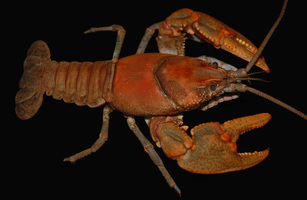 | Back to e-WV
| Back to e-WV
 The West Virginia Encyclopedia
The West Virginia Encyclopedia
 | Back to e-WV
| Back to e-WV
 The West Virginia Encyclopedia
The West Virginia Encyclopedia

Crayfishes, also known as crawfish, crawdads, crawcrabs, or mudbugs, are crustaceans that resemble small lobsters and occur throughout West Virginia’s brooks, streams, rivers, and wetlands. The most notable anatomy associated with crayfish are their claws, which they use to defend themselves and to excavate burrows in streams, streambanks, and wetlands. Other notable anatomy includes the cephalothorax, the forward section including the head and to which the two claws and eight walking legs attach, and the abdomen, which crayfish use to propel themselves backward when disturbed.
Not surprisingly, such an interesting and commonly observed creature has left its mark on the culture and even the language: One may be said to “crawfish,” or back out, of an unpleasant situation or a bad deal. Many young West Virginians’ initiation into nature involves stalking and catching crayfish in their hollow’s stream or a neighborhood creek. Crayfish have never found their way into the diet of West Virginia as they have in some states further south, but no doubt they have been eaten in emergency situations and in lean times. Nowadays crayfish are used primarily by fishermen as effective bait for many species of game fish. Freshly molted crayfish, referred to as “soft craws,” are a cherished bait for smallmouth bass and various species of catfish.
West Virginia is home to roughly 30 species of crayfish. Different species are allied with different aquatic habitats. West Virginia’s largest crayfish live in rivers, where they burrow under boulders and rock slabs. At nine inches long, the New River Crayfish (Cambarus chasmodactylus) is West Virginia’s largest native crayfish. Ironically, the New River Crayfish only occurs in the Greenbrier River in West Virginia, and does not occur in West Virginia’s portion of the New River. The most common large species in West Virginia is the Big Water Crayfish (Cambarus robustus), which occurs throughout much of central and northern West Virginia. The Common Crayfish (Cambarus bartonii bartonii), Appalachian Brook Crayfish (Cambarus bartonii cavatus) and Rock Crawfish (Cambarus carinirostris) are important predators and scavengers in West Virginia’s headwater streams. These three species do not occur in the same streams in West Virginia. They are relegated to specific river basins across the state, and are the species that occur alongside salamanders in West Virginia’s many hollows.
Burrowing crayfishes excavate burrows in wetlands, wet ditches, stream banks, and sometimes even lawns. Chimneys or small turrets of mud, often are produced by burrowing crayfishes, and mark the entrance to their burrows. As a result of their subterranean lifestyle, burrowing crayfishes have shorter abdomens, and tall, vaulted cephalothoraxes compared to crayfishes that live in streams and rivers. Burrowing crayfish are important ecosystem engineers, creating tunnels that are frequented by several different species of animals. Frogs, snakes, rodents, and countless invertebrates use crayfish burrows as refuges, making burrowing crayfish keystone species that other animals are dependent on. Stream crayfishes also burrow extensively, providing the same service for fish and other aquatic organisms that need access to spaces under rocks for breeding, foraging, and other activities. Crayfish eat a wide variety of plants and animals, and themselves are eaten by a multitude of other animals, making them extremely important in stream dynamics. Hellbender salamanders, smallmouth bass, rockbass, river otters, and raccoons are just a few animals that rely heavily on crayfish as part of their diet.
West Virginia is home to the Elk River Crayfish (Cambarus elkensis), West Virginia Cave Crayfish (Cambarus nerterius), and the Greenbrier Crayfish (Cambarus smilax), three species whose entire global range falls within the confines of the Mountain State. The Tug Valley Crayfish (Cambarus hatfieldi) is limited to the Tug River basin, most of which is in West Virginia. The Big Sandy crayfish (Cambarus callainus) recently was identified in the Big Sandy watershed. In addition to the previous species, several varieties of crayfish still undescribed in the scientific literature either occur solely or partially in West Virginia’s portion of the Central Appalachians. Other notable crayfish species occurring in West Virginia include the Blue Crayfish (Cambarus monongalensis), which occurs throughout central and northern West Virginia, as well as West Virginia’s Allegheny Mountains. Hikers travelling through Cranberry Wilderness or Dolly Sods encounter these animals on wet, overcast days.
Globally, crayfish are considered one of the most endangered animal groups on the planet. Stream sedimentation associated with poor land management is an important threat to West Virginia’s crayfishes. Excess sediments clog the spaces between rocks in streams, and make maintaining burrows very difficult for crayfish. The Guyandotte Crayfish (Cambarus veteranus) range in West Virginia has been drastically reduced because of this and other forms of environmental degradation occurring in West Virginia’s coal fields, and consequently is West Virginia’s most imperiled crayfish. In 2016, the U.S. Fish and Wildlife Service listed the Guyandotte Crayfish as an endangered species and the Big Sandy crayfish as a threatened species. Left-over crayfish brought in from out of state as fish bait pose an important threat. Released alive, they may establish local breeding populations. Virile Crayfish (Orconectes virilis) and Rusty Crayfish (Orconectes rusticus) currently reside across the state, eliminating native crayfish through competition. Invasive crayfish not only eliminate native crayfish, but also eliminate important habitat used by game fish for spawning, resulting in a decreased fishery. To avoid this problem, fishermen should use crayfishes collected from the water body they are fishing in.
Written by Zachary Loughman